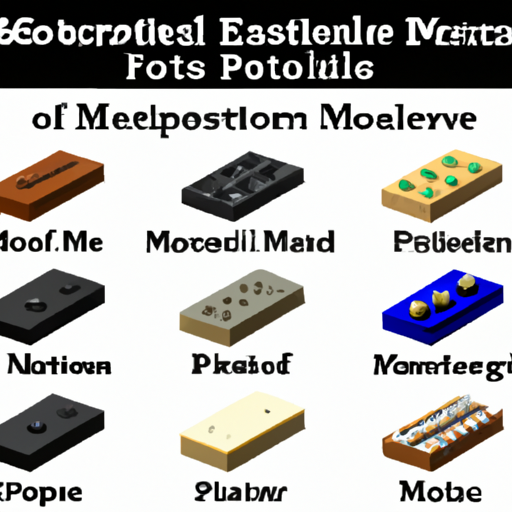What are the Popular Models in the Top 10 Mainstream Resistor Categories?
Introduction
Resistors are fundamental components in electronic circuits, playing a crucial role in controlling current flow, dividing voltages, and protecting sensitive components. They are essential for ensuring that electronic devices function correctly and reliably. This article aims to explore popular models within the top 10 mainstream resistor categories, providing insights into their characteristics, applications, and advantages.
1. Understanding Resistors
Definition and Function of Resistors
A resistor is a passive electrical component that resists the flow of electric current, creating a voltage drop across its terminals. The primary function of a resistor is to limit current, divide voltages, and dissipate energy in the form of heat.
Overview of Resistance, Voltage, and Current Relationship (Ohm's Law)
The relationship between resistance (R), voltage (V), and current (I) is defined by Ohm's Law, which states that V = I × R. This fundamental principle helps engineers and designers calculate the necessary resistance values for their circuits.
Importance of Resistor Specifications
When selecting resistors, several specifications are critical, including tolerance (the allowable deviation from the nominal resistance value), power rating (the maximum power the resistor can dissipate without damage), and temperature coefficient (how resistance changes with temperature). Understanding these specifications ensures that the chosen resistor will perform reliably in its intended application.
2. Categories of Resistors
Resistors can be categorized based on various criteria, including their construction, application, and material. This categorization helps in selecting the right type of resistor for specific applications, ensuring optimal performance and reliability.
3. Popular Resistor Categories
3.1. Carbon Film Resistors
**Description and Characteristics**
Carbon film resistors are made by depositing a thin layer of carbon on a ceramic substrate. They are known for their stability and low noise levels.
**Popular Models**
Yageo CFR-25JB-52-1K: A widely used carbon film resistor known for its reliability and precision.
Vishay MRS25: Offers excellent temperature stability and low noise.
**Applications and Advantages**
Carbon film resistors are commonly used in general-purpose applications, audio equipment, and signal processing due to their low cost and good performance.
3.2. Metal Film Resistors
**Description and Characteristics**
Metal film resistors are constructed using a thin film of metal, providing high accuracy and stability.
**Popular Models**
Vishay Dale CMF series: Known for its precision and low temperature coefficient.
Panasonic ERJ series: Offers a wide range of resistance values and power ratings.
**Applications and Advantages**
These resistors are ideal for precision applications, such as instrumentation and measurement devices, due to their low noise and high stability.
3.3. Wirewound Resistors
**Description and Characteristics**
Wirewound resistors are made by winding a wire around a ceramic or fiberglass core. They can handle high power and are known for their durability.
**Popular Models**
Ohmite 50W: A robust wirewound resistor suitable for high-power applications.
Vishay WSL series: Offers low inductance and high power ratings.
**Applications and Advantages**
Wirewound resistors are commonly used in power supplies, motor controls, and high-current applications due to their ability to dissipate heat effectively.
3.4. Thick Film Resistors
**Description and Characteristics**
Thick film resistors are made by printing a thick layer of resistive material onto a substrate. They are cost-effective and versatile.
**Popular Models**
Vishay MRS series: Known for its reliability and wide range of resistance values.
Bourns 3300 series: Offers good performance in compact designs.
**Applications and Advantages**
These resistors are widely used in consumer electronics, automotive applications, and telecommunications due to their low cost and good performance.
3.5. Thin Film Resistors
**Description and Characteristics**
Thin film resistors are made by depositing a thin layer of resistive material, providing high precision and stability.
**Popular Models**
Vishay Z201 series: Offers excellent temperature stability and low noise.
Panasonic ERJ-2 series: Known for its compact size and reliability.
**Applications and Advantages**
Thin film resistors are ideal for high-precision applications, such as medical devices and aerospace electronics, due to their accuracy and stability.
3.6. Variable Resistors (Potentiometers)
**Description and Characteristics**
Variable resistors, or potentiometers, allow for adjustable resistance. They are commonly used for volume control and tuning applications.
**Popular Models**
Bourns 3386 series: A versatile potentiometer suitable for various applications.
Alpha RV series: Known for its reliability and smooth operation.
**Applications and Advantages**
Potentiometers are widely used in audio equipment, consumer electronics, and industrial controls, providing user-adjustable settings.
3.7. Photoresistors (LDRs)
**Description and Characteristics**
Photoresistors, or light-dependent resistors (LDRs), change resistance based on light exposure. They are used in light-sensing applications.
**Popular Models**
GL5528: A common LDR known for its sensitivity to light.
LDR-02: Offers good performance in various lighting conditions.
**Applications and Advantages**
Photoresistors are used in automatic lighting systems, cameras, and light meters, providing a simple solution for light detection.
3.8. Thermistors
**Description and Characteristics**
Thermistors are temperature-sensitive resistors that change resistance with temperature variations. They are available in two types: NTC (negative temperature coefficient) and PTC (positive temperature coefficient).
**Popular Models**
NTC thermistors from EPCOS: Known for their accuracy in temperature measurement.
Vishay NTCS series: Offers a wide range of temperature coefficients.
**Applications and Advantages**
Thermistors are commonly used in temperature sensing, compensation, and control applications, providing precise temperature measurements.
3.9. SMD Resistors
**Description and Characteristics**
Surface-mount device (SMD) resistors are compact resistors designed for surface mounting on PCBs. They are known for their small size and high reliability.
**Popular Models**
Yageo RC series: Offers a wide range of resistance values and power ratings.
Vishay CRCW series: Known for its high precision and low noise.
**Applications and Advantages**
SMD resistors are widely used in modern electronics, including smartphones, computers, and automotive applications, due to their space-saving design.
3.10. High-Power Resistors
**Description and Characteristics**
High-power resistors are designed to handle significant power levels, making them suitable for demanding applications.
**Popular Models**
Caddock MP series: Known for its high power ratings and low thermal resistance.
Ohmite 50W series: Offers robust performance in high-power applications.
**Applications and Advantages**
High-power resistors are commonly used in power supplies, motor drives, and industrial equipment, providing reliable performance under heavy loads.
4. Factors Influencing Resistor Selection
When selecting resistors, several key factors must be considered:
Application Requirements: The specific needs of the circuit, such as resistance value, power rating, and tolerance, must be met.
Environmental Conditions: Factors like temperature, humidity, and exposure to chemicals can affect resistor performance.
Cost: Budget constraints may influence the choice of resistor type and model.
Understanding these factors ensures that the selected resistor will perform optimally in its intended application.
5. Future Trends in Resistor Technology
As technology advances, resistor design and manufacturing are evolving. Emerging trends include:
Miniaturization: The demand for smaller, more efficient components is driving the development of compact resistor designs.
Smart Resistors: Innovations in materials and technology are leading to the creation of smart resistors that can provide real-time data on performance and conditions.
Sustainability: There is a growing focus on environmentally friendly materials and manufacturing processes in resistor production.
These advancements are expected to impact the electronics industry significantly, leading to more efficient and reliable devices.
Conclusion
Understanding the various categories of resistors and their popular models is essential for anyone involved in electronics design and engineering. By selecting the right type of resistor for specific applications, engineers can ensure optimal performance and reliability in their circuits. As technology continues to evolve, staying informed about resistor technology will be crucial for future innovations in the electronics industry.
References
- "Resistor Basics: Understanding Resistor Types and Applications." Electronics Tutorials.
- "The Role of Resistors in Electronic Circuits." All About Circuits.
- "Resistor Selection Guide." Digi-Key Electronics.
- "Advancements in Resistor Technology." IEEE Spectrum.
What are the Popular Models in the Top 10 Mainstream Resistor Categories?
Introduction
Resistors are fundamental components in electronic circuits, playing a crucial role in controlling current flow, dividing voltages, and protecting sensitive components. They are essential for ensuring that electronic devices function correctly and reliably. This article aims to explore popular models within the top 10 mainstream resistor categories, providing insights into their characteristics, applications, and advantages.
1. Understanding Resistors
Definition and Function of Resistors
A resistor is a passive electrical component that resists the flow of electric current, creating a voltage drop across its terminals. The primary function of a resistor is to limit current, divide voltages, and dissipate energy in the form of heat.
Overview of Resistance, Voltage, and Current Relationship (Ohm's Law)
The relationship between resistance (R), voltage (V), and current (I) is defined by Ohm's Law, which states that V = I × R. This fundamental principle helps engineers and designers calculate the necessary resistance values for their circuits.
Importance of Resistor Specifications
When selecting resistors, several specifications are critical, including tolerance (the allowable deviation from the nominal resistance value), power rating (the maximum power the resistor can dissipate without damage), and temperature coefficient (how resistance changes with temperature). Understanding these specifications ensures that the chosen resistor will perform reliably in its intended application.
2. Categories of Resistors
Resistors can be categorized based on various criteria, including their construction, application, and material. This categorization helps in selecting the right type of resistor for specific applications, ensuring optimal performance and reliability.
3. Popular Resistor Categories
3.1. Carbon Film Resistors
**Description and Characteristics**
Carbon film resistors are made by depositing a thin layer of carbon on a ceramic substrate. They are known for their stability and low noise levels.
**Popular Models**
Yageo CFR-25JB-52-1K: A widely used carbon film resistor known for its reliability and precision.
Vishay MRS25: Offers excellent temperature stability and low noise.
**Applications and Advantages**
Carbon film resistors are commonly used in general-purpose applications, audio equipment, and signal processing due to their low cost and good performance.
3.2. Metal Film Resistors
**Description and Characteristics**
Metal film resistors are constructed using a thin film of metal, providing high accuracy and stability.
**Popular Models**
Vishay Dale CMF series: Known for its precision and low temperature coefficient.
Panasonic ERJ series: Offers a wide range of resistance values and power ratings.
**Applications and Advantages**
These resistors are ideal for precision applications, such as instrumentation and measurement devices, due to their low noise and high stability.
3.3. Wirewound Resistors
**Description and Characteristics**
Wirewound resistors are made by winding a wire around a ceramic or fiberglass core. They can handle high power and are known for their durability.
**Popular Models**
Ohmite 50W: A robust wirewound resistor suitable for high-power applications.
Vishay WSL series: Offers low inductance and high power ratings.
**Applications and Advantages**
Wirewound resistors are commonly used in power supplies, motor controls, and high-current applications due to their ability to dissipate heat effectively.
3.4. Thick Film Resistors
**Description and Characteristics**
Thick film resistors are made by printing a thick layer of resistive material onto a substrate. They are cost-effective and versatile.
**Popular Models**
Vishay MRS series: Known for its reliability and wide range of resistance values.
Bourns 3300 series: Offers good performance in compact designs.
**Applications and Advantages**
These resistors are widely used in consumer electronics, automotive applications, and telecommunications due to their low cost and good performance.
3.5. Thin Film Resistors
**Description and Characteristics**
Thin film resistors are made by depositing a thin layer of resistive material, providing high precision and stability.
**Popular Models**
Vishay Z201 series: Offers excellent temperature stability and low noise.
Panasonic ERJ-2 series: Known for its compact size and reliability.
**Applications and Advantages**
Thin film resistors are ideal for high-precision applications, such as medical devices and aerospace electronics, due to their accuracy and stability.
3.6. Variable Resistors (Potentiometers)
**Description and Characteristics**
Variable resistors, or potentiometers, allow for adjustable resistance. They are commonly used for volume control and tuning applications.
**Popular Models**
Bourns 3386 series: A versatile potentiometer suitable for various applications.
Alpha RV series: Known for its reliability and smooth operation.
**Applications and Advantages**
Potentiometers are widely used in audio equipment, consumer electronics, and industrial controls, providing user-adjustable settings.
3.7. Photoresistors (LDRs)
**Description and Characteristics**
Photoresistors, or light-dependent resistors (LDRs), change resistance based on light exposure. They are used in light-sensing applications.
**Popular Models**
GL5528: A common LDR known for its sensitivity to light.
LDR-02: Offers good performance in various lighting conditions.
**Applications and Advantages**
Photoresistors are used in automatic lighting systems, cameras, and light meters, providing a simple solution for light detection.
3.8. Thermistors
**Description and Characteristics**
Thermistors are temperature-sensitive resistors that change resistance with temperature variations. They are available in two types: NTC (negative temperature coefficient) and PTC (positive temperature coefficient).
**Popular Models**
NTC thermistors from EPCOS: Known for their accuracy in temperature measurement.
Vishay NTCS series: Offers a wide range of temperature coefficients.
**Applications and Advantages**
Thermistors are commonly used in temperature sensing, compensation, and control applications, providing precise temperature measurements.
3.9. SMD Resistors
**Description and Characteristics**
Surface-mount device (SMD) resistors are compact resistors designed for surface mounting on PCBs. They are known for their small size and high reliability.
**Popular Models**
Yageo RC series: Offers a wide range of resistance values and power ratings.
Vishay CRCW series: Known for its high precision and low noise.
**Applications and Advantages**
SMD resistors are widely used in modern electronics, including smartphones, computers, and automotive applications, due to their space-saving design.
3.10. High-Power Resistors
**Description and Characteristics**
High-power resistors are designed to handle significant power levels, making them suitable for demanding applications.
**Popular Models**
Caddock MP series: Known for its high power ratings and low thermal resistance.
Ohmite 50W series: Offers robust performance in high-power applications.
**Applications and Advantages**
High-power resistors are commonly used in power supplies, motor drives, and industrial equipment, providing reliable performance under heavy loads.
4. Factors Influencing Resistor Selection
When selecting resistors, several key factors must be considered:
Application Requirements: The specific needs of the circuit, such as resistance value, power rating, and tolerance, must be met.
Environmental Conditions: Factors like temperature, humidity, and exposure to chemicals can affect resistor performance.
Cost: Budget constraints may influence the choice of resistor type and model.
Understanding these factors ensures that the selected resistor will perform optimally in its intended application.
5. Future Trends in Resistor Technology
As technology advances, resistor design and manufacturing are evolving. Emerging trends include:
Miniaturization: The demand for smaller, more efficient components is driving the development of compact resistor designs.
Smart Resistors: Innovations in materials and technology are leading to the creation of smart resistors that can provide real-time data on performance and conditions.
Sustainability: There is a growing focus on environmentally friendly materials and manufacturing processes in resistor production.
These advancements are expected to impact the electronics industry significantly, leading to more efficient and reliable devices.
Conclusion
Understanding the various categories of resistors and their popular models is essential for anyone involved in electronics design and engineering. By selecting the right type of resistor for specific applications, engineers can ensure optimal performance and reliability in their circuits. As technology continues to evolve, staying informed about resistor technology will be crucial for future innovations in the electronics industry.
References
- "Resistor Basics: Understanding Resistor Types and Applications." Electronics Tutorials.
- "The Role of Resistors in Electronic Circuits." All About Circuits.
- "Resistor Selection Guide." Digi-Key Electronics.
- "Advancements in Resistor Technology." IEEE Spectrum.













